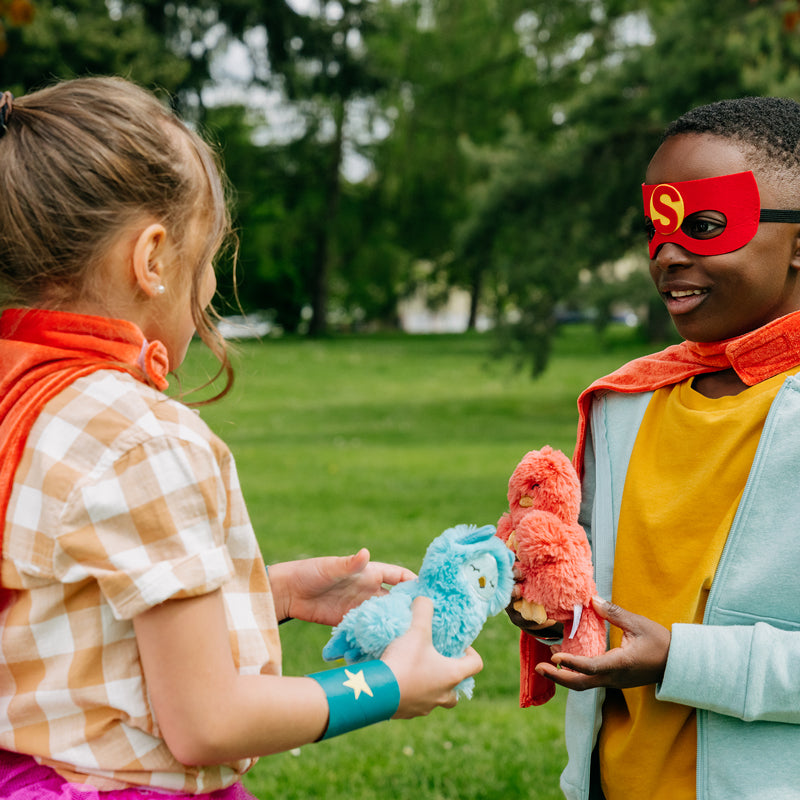It may seem intuitive that empathy and showing kindness are prosocial-behaviors. The old saying goes, “you catch more bees with honey.” Teaching kindness and empathy helps kids learn to regulate their own emotions, encourages inclusion, connection, and belonging, it supports kids' growth mindset and perspective taking. Leading with empathy also has benefits for your child. Being inclusive and empathetic can help them to be more resilient, confident, and encourages self-acceptance.
With all the benefits associated with showing kindness and empathy, how can we as caregivers strengthen our child's empathy and kindness muscles?
Discuss Emotions Regularly
Helping children learn emotional identification and literacy has numerous social emotional benefits. When a child has the words to define how they feel, they are better able to interpret the emotions of others. Reading stories like The Feels, The Creatures Full of Feelings, Hero Camp, and Ibex’s stories help children understand that all emotions are welcome and each feeling has a message to share. For example, mad is not bad, mad lets us know that something doesn’t feel fair. Or our sad teaches us that we care.
Modeling prosocial behaviors is one of the strongest tools we have as caregivers. It can be easy during moments of distress to let ourselves be triggered by our children's large emotions. It is normal for screaming and hitting to put us into a state of distress, but if we can regulate our emotional responses and be the calm in the midst of the chaos we are not only modeling regulation, we are offering a safe space to land. Saying things during moments of heightened emotions such as, “I can see that you are very mad and frustrated that we have to leave the park. I know it can be hard to leave somewhere when you are having fun, but we cannot scream when we are frustrated.” These types of statements acknowledge our children's emotions and help our children to feel seen and heard by us. This allows them to also reflect when others are experiencing heightened emotions. Self compassion is also important. Are you upset from things you heard on the news? Explain that, I am sad because the news feels a bit overwhelming and scary. It’s ok to feel sad because it lets me know I care. Do you want to snuggle and read a story with me? Hugs and snuggles always help my heart feel better.”
Playground and sibling conflicts are a great opportunity for teaching perspective taking. Perspective taking is when we are able to see something from someone else's point of view. It is a really complex developmental milestone and won't happen all at once, but talking about it and encouraging it can help your children develop and master this wonderful skill. For example, your kids are playing soccer in the yard. Your older child keeps scoring on your younger child and they become frustrated and stomp inside declaring they never want to play soccer with their sibling again! There are so many lessons to be learned in this situation, but one easy one is to encourage the older child to think about how they would feel if roles were reversed. Would they want to play with their sibling if they never were able to get the ball or score? Then ask them to think about a way where they can both play and have fun together.
The power of play, creativity and imagination are endless. Role playing and pretending with dolls or figurines is a really fun and easy way to help your child show empathy. Children learn by doing. Applying social skills like empathy during play, lets them test out cause and effect. Playing with your child also helps your child feel more connected to you. When we engage with our children, ask meaningful questions, and take an interest in their likes and dislikes, it is yet again modeling empathetic and kind behavior. Really anytime you have the opportunity to talk about emotions and practice emotional expression you are setting your child up for a great understanding of themselves and of others.
This short list of tips is not meant to be an all encompassing list, but a starting point, please share some of your family’s advice on building empathy and kindness in your home in the comments below!







